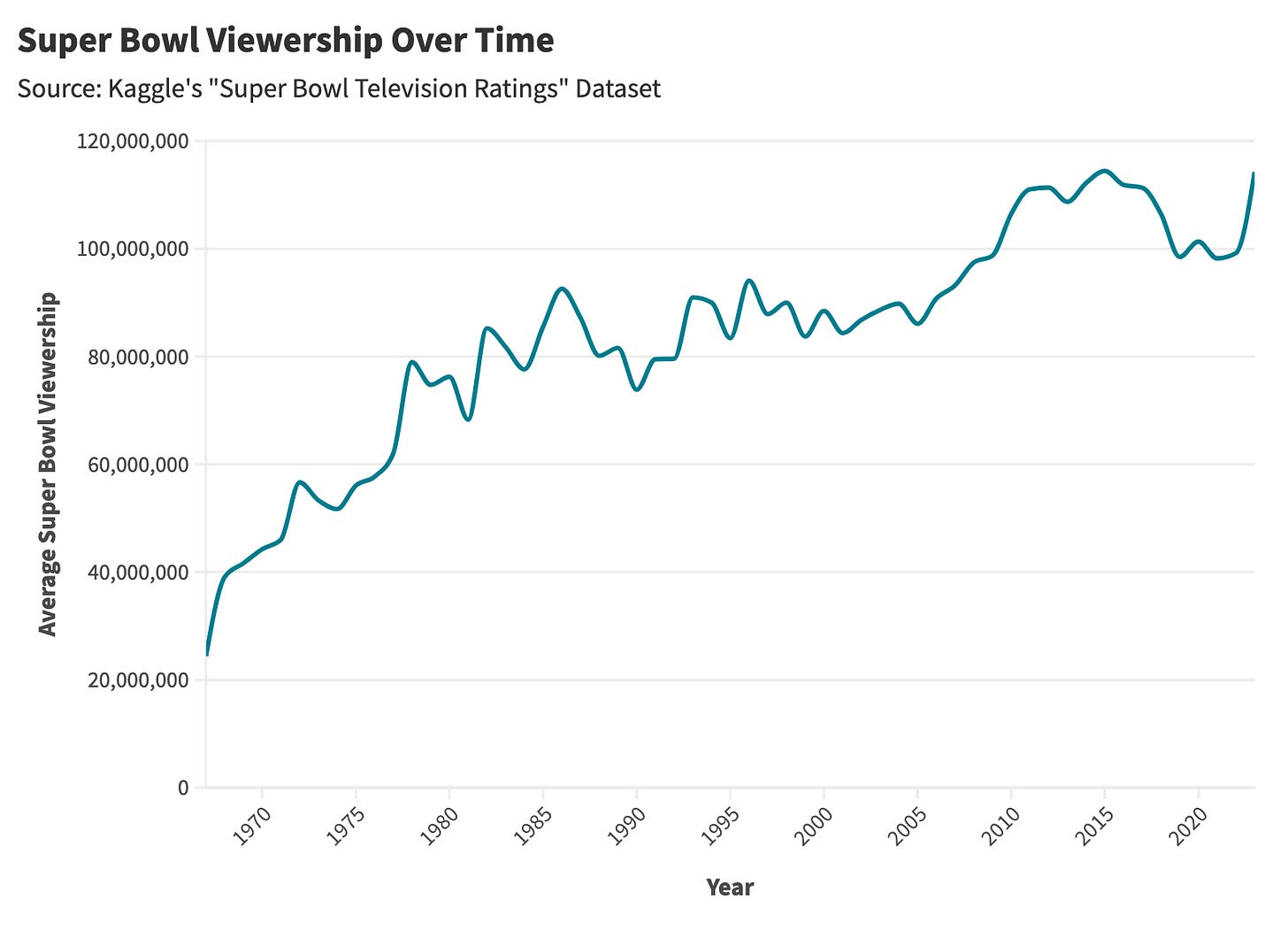The Mind-Boggling Reach of Super Bowl Commercials: A Statistical Analysis
Analyzing the enormous reach of Super Bowl commercials.
Intro: What Makes The Super Bowl Different?
Every celebration has idiosyncratic traditions that are so long-standing they are rarely questioned. For example, why do we search for eggs and eat Peeps on Easter? Why do we sing carols and watch It's a Wonderful Life on Christmas? Why do we scrutinize the actions of a random woodchuck on Groundhog Day? And, most relevant to this week's events, why do we cherish commercials that run during The Super Bowl?
This year's Super Bowl will attract an estimated 120 million viewers, making this program the second-most watched broadcast of all time—after the moon landing.
There will be 70 big-budget commercials interspersed throughout the game, with each advertisement costing an absurd $7 million per 30-second timeslot. And yet, unlike all other nights when commercials are a hindrance, viewers will relish these ads, dazzled by the wonders of corporate marketing.
So today, we'll explore The Super Bowl's ever-growing cultural dominance, America's odd infatuation with Super Bowl advertisements, and the absurd reach of these commercials.
The Ever-Growing Wonder of Super Bowl Ads
The first Super Bowl was played in 1967 and garnered an average viewership of 24.4 million as the Green Bay Packers defeated the Kansas City Chiefs 35–10. In the 57 years since, the NFL has become a cultural juggernaut, with football becoming America's most popular sport and the NFL becoming the most valuable sports league globally. In 2023, NFL games comprised 93 of the top 100 television broadcasts. This year's Super Bowl will likely capture between 115 and 130 million viewers, nearly a 6x improvement compared to that first 1967 broadcast.
The first Super Bowl ad cost $37,500, a meager sum relative to today's price tag. Over the next six decades, the NFL would increasingly dominate American sports (and Sundays), eclipsing baseball and inaugurating its championship game as a must-see TV event. As viewership increased, so did the cost of an advertising slot, which significantly outpaced the rate of inflation.
Over time, Super Bowl commercials became events in and of themselves. If hundreds of millions of people are watching and you've paid millions of dollars for 30 seconds of their attention, you probably want to make the most of this time.
Apple's "1984" promotion is often seen as a turning point for Super Bowl advertising. Directed by Ridley Scott (of Alien and Gladiator fame), the commercial shows a heroine shattering a screen that showcases a Big Brother figure, symbolizing Apple's challenge to IBM's dominance.
Scott's advertisement possessed a cinematic quality unlike anything seen in commercials at the time and is credited with establishing The Super Bowl as a marquee event for ambitious advertising projects. Since then, Super Bowl ads have become works of spectacle, 30-second micro-films with equal focus on entertainment value and marketing message.
On most nights, we dislike advertising, but on The Super Bowl, we cherish all that corporate marketing has to offer. A recent YouGov survey found that 14% of viewers consider "the commercials" their favorite part of The Super Bowl.
14% may sound small until you consider the scale of the broadcast. If we assume 120 million viewers will watch this year's Super Bowl, an estimated 17 million will be most intrigued by the advertisements.
Indeed, Super Bowl ads have become an object of cultural celebration, with a reach that greatly surpasses most movies and TV shows. Consider the collective hours spent viewing a single year's Super Bowl commercials. Assuming a base of 120 million viewers watching 70 advertisements with an average length of 40 seconds per ad, we can project nearly 79 million hours of total watch time for this year's commercials (and that doesn't even include their afterlife on YouTube).
That's 9,056 years worth of human time dedicated to the wonders of Doritos and Mountain Dew. Once more, consider this pursuit relative to recent cultural events—coronations, Oscar-winning films, presidential addresses, etc. The only thing that regularly eclipses the collective attention garnered by Super Bowl ads is the act of watching football itself.
These numbers speak to modern media's fragmentation as much as they do the NFL's reach. In a world of ever-multiplying streaming services and infinite TV content, few people watch the same thing at the same time. High-profile TV shows used to be an event, as massive viewership was directed toward a small collection of programming. M*A*S*H's 1983 television finale garnered 106 million viewers, and Seinfeld's 1998 finale captured 76.3 million viewers. Compare these numbers to Succession, arguably the finest show in recent memory, which saw an average of 8.7 million viewers per episode in its final season (with only 2.9 million watching the finale live).
And when people do watch the same show en masse, it's usually asynchronous, far from a widespread event. Apparently, the entire world binge-watched Suits last year and only found out after the fact. There were no Suits watch parties—we simply consumed a highly unrealistic show about lawyers in the privacy of our own homes at our own cadence (myself included).
The Super Bowl and its commercials generate a level of urgency and interest unmatched by any other media event. A 30-second E-trade commercial from this year's Super Bowl will be viewed at a scale that dwarfs that of The White Lotus, The Bear, and Better Call Saul. Better yet, every media outlet in America will dissect this E-trade ad with a fervor reserved for Martin Scorsese films. We will get a series of articles on "The Best Super Bowl Ads of 2024," and we'll read them because why not.
Enjoying the article thus far and want more data-centric pop culture content?
Final Thoughts: Bread and Circuses
What would the Super Bowl be without commercials? Suppose the NFL switched to a subscription model; would this broadcast still entertain such a broad base of consumers? Probably not.
Many holidays allow us to embrace certain vices. On the Fourth of July, we embrace unfettered patriotism and pyrotechnics. On Thanksgiving, we embrace gluttony (and also football). And on The Super Bowl, we embrace the spectacle of American commercialism.
There is a famous phrase from ancient Rome that emphasizes a populace's need for "bread and circuses." In a sociopolitical context, the phrase refers to winning public approval not through outstanding public service or policy but by offering distractions and meeting base requirements. Roman Emperors heeded this advice by providing their citizens with plenty of circuses, including gladiator fights and chariot races.
In many ways, The Super Bowl epitomizes our need for bread and circuses, except the bread is Doritos, and the circus is the Pepsi Halftime Show. Am I saying that The Super Bowl is some far-flung government plot to distract the populace? No. Do I think The Super Bowl and its commercials are a gigantic distraction? Absolutely.
In fact, The Super Bowl is the most incredible distraction produced by humankind (second only to a broadcast featuring a human walking on the moon). One day a year, we convene to celebrate distraction and eat Tostitos—and it's a truly fantastic day.
Want to chat about data and statistics? Have an interesting data project? Just want to say hi? Email daniel@statsignificant.com











